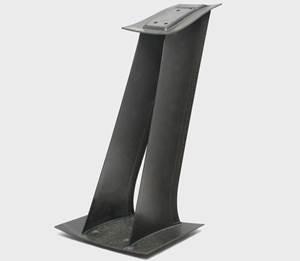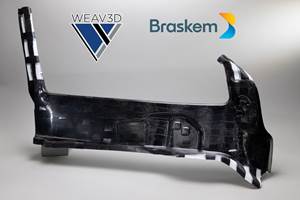Composites in Sailboats: Room to Grow
Composites continue to play a key role in the sailboat industry, having become almost universal at all levels of sailboat custom and production manufacturing. Composite sailboat building started with the famous Bounty design in the 1950s, and in much of the industry, basic manufacturing practice has changed little
Composites continue to play a key role in the sailboat industry, having become almost universal at all levels of sailboat custom and production manufacturing. Composite sailboat building started with the famous Bounty design in the 1950s, and in much of the industry, basic manufacturing practice has changed little from the original "bucket and brush"approach - wetting out dry E-glass reinforcements with liquid polyester resin in a female mold. However, a growing number of manufacturers have stepped up to more sophisticated infusion molding techniques, which include vacuum infusion processes as well as proprietary, licensed systems, such as the Pearson/J-boats SCRIMP system and VEC LLC's VEC Technology. These techniques have bridged the gap in laminate quality and repeatability between open molding and prepreg systems. However, even manufacturers who plan on runs of 50 to 100 units or more change models often enough that the investment in close molding is not deemed worthwhile in a market that is very price/cost driven.
That said, most boatbuilders have placed greater emphasis on quality control. Personnel are more carefully trained. Attention has been given to precise resin catalyst levels and closely controlled measurement of resin volume for a particular part or layup. These precautions have resulted in much narrower tolerances in laminate weight, strength and repeatability. Further, vinyl ester resins are often used for the laminate on the outside of the hull and core (if not the entire laminate) to improve saltwater blister resistance, with isopolyesters used on the inner laminate to moderate cost. While reinforcements remain almost universally E-glass, traditional mat and woven roving have been exchanged for stitched or knitted multiply fabrics that produce higher mechanical values while they reduce resin consumption.
Today, it also is becoming common practice for hulls to be uncored, solid laminate below the waterline, with balsa or foam cores above the waterline and in the decks. Structural rigidity is provided by sophisticated interior liner laminate grids that are bonded to the hull with a variety of tough and immensely strong modern adhesives. Interior detail and cabinetry is moving toward combinations of composite laminate and traditional woodworking.
In higher-end production sailboats, the trend is strong toward closed molding processes for the large hull and liner laminates. The processes, properly executed, produce very low void, low resin fraction laminates with mechanical properties significantly better than even the most carefully controlled open mold laminates. Owners pay a premium for boats built this way, but the resulting sailboats usually have high resale value and a deserved reputation for durability and performance.
Racing yacht manufacturing, however, has moved to a plane where it is little removed from aerospace practice, and indeed, many high-end shops also contract with the aerospace industry. Prepreg reinforcements, usually carbon fiber, are combined with sophisticated foam and honeycomb cores and film adhesives are combined in parts that are vacuum bagged cured in computer-controlled ovens or autoclaves. are cured in precision-machined molds, bagged and oven- or autoclave-cured, producing aerospace-quality parts that include 80-ft America's Cup yacht hulls and masts hundreds of feet high. Virtually all mast and spar makers have invested in autoclaves for the production of carbon fiber spars, some of them many tens of meters long, using standard and medium modulus carbon fiber/epoxy prepregs exclusively.
The best prospect for mass market penetration by carbon composites is in masts and spars. Today, no serious competition sailboat, small or large, is built without them. When customers see how a carbon spar reduces weight aloft and contributes to stability and sail-carrying power and, thus, speed, the cost premium over aluminum spars is moot. It is likely that all racing or cruising sailboats with any pretense to quality and performance will be built with a carbon mast within 10 years. High-end, high-performance sail and power cruising boats are starting to follow racing yachts in the use of sophisticated materials and processes, to produce carbon fiber/honeycomb cabinetry, faced with exotic wood veneers and thin-cut marble and granite countertops (see "Composites in Boat Accessories & Hardware,"in this issue, p. 32). These, however, remain the province of cost-is-no-object projects.
In short, one can find every level of production process from the most primitive to the most advanced. The method selected depends on the performance desired and the cost the customer or target market is willing to pay. In the future, rising oil prices may increase the cost of resin and reinforcement, but also may drive designs toward greater efficiency and more sophisticated laminates. Therefore, there could be many opportunities, if advanced processes can be shown to reduce labor and product costs as they increase quality and performance.
Dave Beck is a keen observer of the boating scene and, trading on his BS degrees in engineering and journalism, regularly writes for a number of sailing magazines, including Seahorse, Sailing World and SAIL) - when he's not sailing, which he does as often as possible on a variety of southern California racing sailboats.
Related Content
3D-woven composites find success in aerospace, space
CAMX 2024: Bally Ribbon Mills experts are displaying the company’s various joints, thermal protection system (TPS) technologies and other 3D woven composites for mission-critical applications.
Read More3D weaving capabilities achieve complex shapes, reduce weight and cost
JEC World 2024: Bally Ribbon Mills is displaying film-infused 3D woven joints, woven thermal protection systems (TPS) and woven composite 3D structures.
Read MorePlant tour: Albany Engineered Composites, Rochester, N.H., U.S.
Efficient, high-quality, well-controlled composites manufacturing at volume is the mantra for this 3D weaving specialist.
Read MoreBraskem demonstrates PP solutions using Weav3D composite lattice technology
Partnership combines Braskem’s polypropylene sheets with Weav3D Rebar for Plastics technology to address new structural, automotive applications requiring high-strength, lightweight material solutions.
Read MoreRead Next
Plant tour: Daher Shap’in TechCenter and composites production plant, Saint-Aignan-de-Grandlieu, France
Co-located R&D and production advance OOA thermosets, thermoplastics, welding, recycling and digital technologies for faster processing and certification of lighter, more sustainable composites.
Read More“Structured air” TPS safeguards composite structures
Powered by an 85% air/15% pure polyimide aerogel, Blueshift’s novel material system protects structures during transient thermal events from -200°C to beyond 2400°C for rockets, battery boxes and more.
Read MoreVIDEO: High-volume processing for fiberglass components
Cannon Ergos, a company specializing in high-ton presses and equipment for composites fabrication and plastics processing, displayed automotive and industrial components at CAMX 2024.
Read More










.jpg;maxWidth=300;quality=90)










